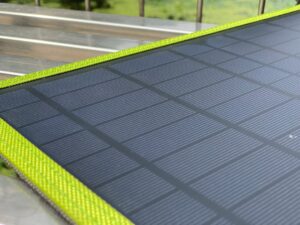Traditional carpet backing has long been a significant contributor to environmental degradation. Typically made from synthetic materials such as polypropylene or polyester, these backings are not biodegradable and can take centuries to decompose in landfills. The production of these materials often involves the use of fossil fuels, leading to high carbon emissions and contributing to climate change.
Furthermore, the manufacturing processes for these synthetic fibers can result in the release of harmful pollutants into the air and water, posing risks to both ecosystems and human health. In addition to the pollution generated during production, traditional carpet backing also contributes to the growing problem of plastic waste. As carpets are replaced or discarded, the non-biodegradable backing ends up in landfills, where it contributes to the ever-increasing volume of plastic waste.
This not only exacerbates the global waste crisis but also poses a threat to wildlife, as animals can ingest or become entangled in discarded materials. The environmental impact of traditional carpet backing is profound, highlighting the urgent need for more sustainable alternatives.
Key Takeaways
- Traditional carpet backing has a significant environmental impact due to the use of non-recyclable materials and the release of harmful chemicals during production and disposal.
- Using recycled nylon for carpet backing offers benefits such as reducing the demand for new raw materials, diverting waste from landfills, and lowering energy consumption and greenhouse gas emissions.
- Recycled nylon for carpet backing is sourced from post-consumer nylon products like fishing nets and processed through cleaning, shredding, and extrusion to create new carpet backing material.
- Carpets with recycled nylon backing are durable, high-performing, and offer the same quality and longevity as those with traditional backing, making them a sustainable and reliable flooring option.
- The cost-effectiveness of using recycled nylon for carpet backing is evident in the long-term savings on raw material procurement and waste management, making it a financially viable choice for both manufacturers and consumers.
The benefits of using recycled nylon for carpet backing
Recycled nylon presents a compelling alternative to traditional carpet backing, offering numerous environmental benefits. One of the most significant advantages is its ability to reduce waste. By repurposing discarded nylon products, such as fishing nets and fabric scraps, manufacturers can divert these materials from landfills and give them a new life as carpet backing.
This not only minimizes waste but also conserves natural resources by reducing the need for virgin materials. Moreover, recycled nylon has a lower carbon footprint compared to its virgin counterpart. The process of recycling nylon requires less energy and generates fewer greenhouse gas emissions than producing new nylon from petrochemicals.
This makes carpets with recycled nylon backing a more environmentally friendly choice for consumers who are increasingly concerned about their ecological impact. Additionally, carpets made with recycled nylon can be just as durable and high-performing as those made with traditional materials, making them an attractive option for both residential and commercial spaces.
How recycled nylon is sourced and processed for carpet backing
The sourcing of recycled nylon for carpet backing involves a meticulous process that begins with the collection of discarded nylon products. This can include a variety of items, such as old fishing nets, industrial waste, and post-consumer textiles. Organizations and companies dedicated to sustainability often collaborate with fishermen and textile manufacturers to gather these materials, ensuring that they are diverted from landfills and oceans.
Once collected, the nylon is cleaned and processed to remove any contaminants. This typically involves shredding the material into smaller pieces, which are then washed and dried. After this initial processing, the nylon is melted down and extruded into new fibers that can be woven or tufted into carpet backing.
This closed-loop recycling process not only reduces waste but also minimizes the environmental impact associated with producing new materials. By transforming discarded nylon into high-quality carpet backing, manufacturers can contribute to a more sustainable future while meeting consumer demand for eco-friendly products.
The durability and performance of carpets with recycled nylon backing
| Metrics | Durability and Performance |
|---|---|
| Wear Resistance | High |
| Stain Resistance | Excellent |
| Color Retention | Good |
| Environmental Impact | Low |
| Recycled Content | High |
Carpets featuring recycled nylon backing are known for their impressive durability and performance characteristics. Recycled nylon fibers possess inherent strength and resilience, making them suitable for high-traffic areas in both residential and commercial settings. These carpets can withstand wear and tear while maintaining their appearance over time, which is a crucial factor for consumers seeking long-lasting flooring solutions.
In addition to their durability, carpets with recycled nylon backing also offer excellent stain resistance and ease of maintenance. The fibers are often treated with advanced technologies that enhance their ability to repel stains and resist fading from sunlight exposure. This means that homeowners and businesses can enjoy beautiful flooring without the constant worry of damage or discoloration.
As a result, carpets made with recycled nylon not only provide aesthetic appeal but also deliver practical benefits that align with modern lifestyle demands.
The cost-effectiveness of using recycled nylon for carpet backing
While some may assume that sustainable materials come with a higher price tag, carpets with recycled nylon backing can be surprisingly cost-effective. The initial investment in these eco-friendly options is often comparable to traditional carpets, especially as advancements in recycling technology continue to improve efficiency and reduce production costs. Additionally, the durability of recycled nylon carpets means that consumers may save money in the long run by avoiding frequent replacements.
Furthermore, many manufacturers are recognizing the growing demand for sustainable products and are adjusting their pricing strategies accordingly. As more companies enter the market with recycled nylon offerings, competition is likely to drive prices down further. This shift not only benefits consumers but also encourages more manufacturers to adopt sustainable practices, creating a positive feedback loop that supports the growth of eco-friendly flooring options.
The growing trend of sustainable and eco-friendly flooring options
The trend towards sustainable and eco-friendly flooring options has gained significant momentum in recent years. As awareness of environmental issues continues to rise, consumers are increasingly seeking products that align with their values. This shift is evident in various sectors of the flooring industry, where traditional materials are being replaced by innovative alternatives that prioritize sustainability.
Carpet manufacturers are responding to this demand by developing a range of eco-friendly products, including those made from recycled materials like nylon. This growing trend reflects a broader societal shift towards sustainability, as individuals and businesses alike recognize the importance of making environmentally conscious choices. By opting for sustainable flooring options, consumers not only contribute to reducing their carbon footprint but also support companies that prioritize ethical practices in their production processes.
The process of manufacturing carpets with recycled nylon backing
The manufacturing process for carpets with recycled nylon backing involves several key steps that ensure quality and sustainability. After sourcing and processing the recycled nylon, manufacturers begin by spinning the fibers into yarns suitable for carpet production. This yarn is then woven or tufted into various carpet styles, allowing for a wide range of design possibilities.
Quality control is an essential aspect of this manufacturing process. Manufacturers conduct rigorous testing to ensure that the recycled nylon meets industry standards for durability, stain resistance, and overall performance. By adhering to these standards, companies can guarantee that their carpets not only meet consumer expectations but also contribute positively to environmental sustainability.
The entire process—from sourcing to production—demonstrates a commitment to reducing waste while delivering high-quality flooring solutions.
The potential for reducing waste and carbon footprint in the carpet industry
The integration of recycled nylon into carpet manufacturing holds significant potential for reducing waste and minimizing the carbon footprint of the industry as a whole. By utilizing discarded materials that would otherwise contribute to landfill overflow or ocean pollution, manufacturers can significantly decrease the volume of waste generated by carpet production. Moreover, the use of recycled materials reduces reliance on virgin resources, which often require extensive energy consumption during extraction and processing.
This shift not only conserves natural resources but also leads to lower greenhouse gas emissions associated with production. As more companies adopt sustainable practices and prioritize recycling initiatives, the carpet industry can move towards a more circular economy—one that values resource efficiency and environmental responsibility.
The role of consumer demand in driving the shift towards sustainable carpeting
Consumer demand plays a pivotal role in driving the shift towards sustainable carpeting options. As individuals become more aware of environmental issues and seek ways to reduce their impact on the planet, they increasingly prioritize products that reflect their values. This growing consciousness has prompted manufacturers to innovate and develop eco-friendly alternatives that meet consumer expectations.
The influence of consumer preferences extends beyond individual purchases; it shapes industry trends and encourages companies to adopt sustainable practices throughout their supply chains. When consumers actively choose carpets made from recycled materials or support brands committed to sustainability, they send a clear message to manufacturers about the importance of eco-friendly options. This collective demand fosters an environment where sustainability becomes not just an option but a necessity within the flooring industry.
The impact of recycled nylon backing on indoor air quality and health
The use of recycled nylon backing in carpets can have a positive impact on indoor air quality and overall health. Traditional carpets often release volatile organic compounds (VOCs) into the air, which can contribute to respiratory issues and other health problems over time. In contrast, many manufacturers of carpets with recycled nylon backing prioritize low-VOC formulations and environmentally friendly adhesives during production.
By choosing carpets made from recycled materials, consumers can create healthier living environments that minimize exposure to harmful chemicals. Additionally, these carpets often feature improved breathability due to their construction methods, further enhancing indoor air quality. As awareness grows regarding the importance of maintaining healthy indoor spaces, carpets with recycled nylon backing emerge as a viable solution for those seeking both comfort and well-being.
The future of sustainable flooring and the role of recycled materials in the industry
The future of sustainable flooring looks promising as innovations continue to emerge within the industry. Recycled materials like nylon are poised to play an increasingly vital role in shaping this future landscape. As technology advances and recycling processes become more efficient, manufacturers will be able to produce high-quality flooring options that meet both aesthetic preferences and environmental standards.
Moreover, as consumer demand for sustainable products continues to rise, it is likely that more companies will invest in research and development focused on eco-friendly materials. This shift could lead to even greater advancements in recycling technologies and alternative materials that further reduce waste and carbon footprints across various flooring categories. Ultimately, the integration of recycled materials into flooring solutions represents not just a trend but a fundamental transformation within the industry—one that prioritizes sustainability while meeting the needs of modern consumers.
FAQs
What is recycled nylon carpet backing?
Recycled nylon carpet backing is a type of carpet backing material that is made from recycled nylon fibers. These fibers are typically sourced from post-consumer nylon products such as old carpets, fishing nets, and industrial waste.
How is recycled nylon carpet backing made?
Recycled nylon carpet backing is made by collecting post-consumer nylon products, cleaning and processing the nylon fibers, and then weaving or knitting them into a durable backing material for carpets. This process helps to divert nylon waste from landfills and reduce the environmental impact of carpet production.
What are the benefits of using recycled nylon carpet backing?
Using recycled nylon carpet backing helps to reduce the demand for new nylon production, conserves natural resources, and reduces the amount of waste sent to landfills. Additionally, it can contribute to a more sustainable and environmentally friendly carpet manufacturing process.
Is recycled nylon carpet backing as durable as traditional carpet backing?
Yes, recycled nylon carpet backing is just as durable as traditional carpet backing. The recycling process does not compromise the strength or performance of the nylon fibers, and the resulting backing material is able to provide the necessary support and stability for carpets.
Can recycled nylon carpet backing be recycled again?
Yes, recycled nylon carpet backing can typically be recycled again at the end of its life cycle. This helps to create a closed-loop system for nylon products, further reducing the environmental impact of carpet production and disposal.






